Weeding Pavers: Essential Guide for Homeowners
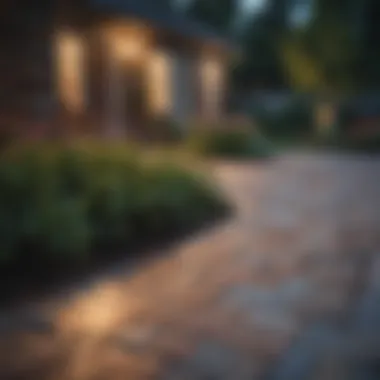

Intro
Maintaining pavers is more than just an aesthetic responsibility; it is integral to ensuring the longevity and structural integrity of your outdoor spaces. Homeowners often face challenges with weed growth, which can not only ruin the visual appeal of walkways and patios but also increase maintenance demands over time. Understanding effective weeding techniques becomes crucial in preserving both beauty and functionality.
Investing time in proper weeding paver techniques pays off in the long run. This article explores essential methods to tackle weed issues, while also addressing various preventative measures and the right tools for optimal results. With the right knowledge, homeowners can achieve a tidy and appealing outdoor environment.
Design Inspiration
Creating a visually appealing outdoor space begins with understanding current design trends. Using pavers not only enhances functionality but also adds character to your garden or patio.
Trending Styles
The use of natural stones, permeable pavers, and innovative layouts stands at the forefront of contemporary design. Homeowners should consider unique shapes and sizes that complement their landscaping.
The following popular styles can inspire your choices:
- Geometric patterns: These create a striking visual, often drawing attention to specific garden features.
- Curved pathways: They integrate well with natural surroundings, offering a softer look.
- Textured finishes: These can enhance grip while adding depth to the design.
Color Palettes
Selecting the right colors is vital for harmonizing your design. Neutral tones often serve as a foundation, allowing vibrant plants to stand out. Alternatively, darker shades may add an elegant aesthetic to modern designs.
Here are some suggested color combinations:
- Gray and charcoal: These create a sleek, contemporary look.
- Earthy browns and tans: They blend well into natural landscapes.
- Soft pastels: These can inject a whimsical touch, complementing floral themes.
Practical Tips
Caring for pavers goes beyond weeding; it encompasses consistent maintenance and thoughtful planning.
Maintenance & Care
Regular cleaning is necessary to prevent weed growth and staining. Homeowners can utilize various tools such as pressure washers for tough dirt or brushes for smaller areas.
Best maintenance practices include:
- Inspecting joints: This checks for any erosion or gaps where weeds can thrive.
- Sealing pavers: Applying sealants can reduce weed growth and staining.
- Using landscaping fabric: This can act as a barrier beneath pavers, minimizing weed intrusion.
Budgeting & Planning
Prior to installing or maintaining pavers, budgeting aids in making informed choices. Determine whether to hire professionals or undertake the tasks personally.
To effectively budget for your weeding and maintenance needs, consider the following steps:
- Assess initial costs for paver materials.
- Calculate ongoing maintenance expenses, including tools and time.
- Plan for potential professional services for larger tasks.
"A well-maintained outdoor space enhances property value while providing comfort and enjoyment for residents and guests alike."
Understanding Weeding in the Context of Pavers
Weeding is a crucial aspect of maintaining paver installations. It involves the removal of unwanted plant growth that can undermine the aesthetic appeal and structural integrity of paved areas. Understanding weeding in this specific context allows homeowners to appreciate its role not just as a chore, but as a necessary maintenance task that safeguards their outdoor investments.
Definition of Weeding
Weeding refers to the practice of removing or controlling weeds in various environments, including gardens, lawns, and paved areas. In the case of pavers, it involves the meticulous elimination of plants that appear in the joints between stones or along the edges of pathways or patios. Weeds can vary from small dandelions to vigorous plant species that can establish deep roots, which may damage the underlying base of the paver system. Regular weeding is essential to ensure that these unwanted plants do not take hold and spread, which can lead to an unsightly appearance and potential damage.
Importance of Weeding Pavers
Weeding pavers is important for several reasons:
- Aesthetic Appeal: A clean, weed-free paved area enhances the visual beauty of your outdoor space. Weeds can create a chaotic look, detracting from the design and overall enjoyment of the area.
- Structural Integrity: Weeds can cause damage to pavers by lifting them or breaking the joints, leading to uneven surfaces. By removing weeds promptly, homeowners can protect their investment and avoid costly repairs.
- Health of Surrounding Plants: Weeds often compete with desirable plants for resources, including water and nutrients. By keeping paver spaces free of weeds, you promote the health of your garden and landscaped areas.
- Pest Control: Weeds can attract pests, which may later spread to other areas. A well-maintained paver area reduces the habitat available for insects and rodents.
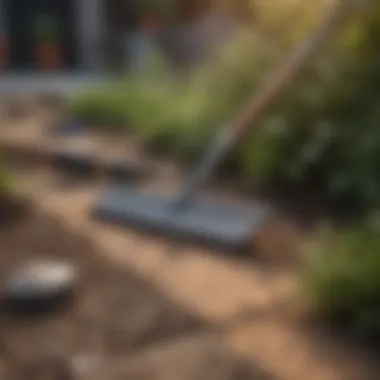
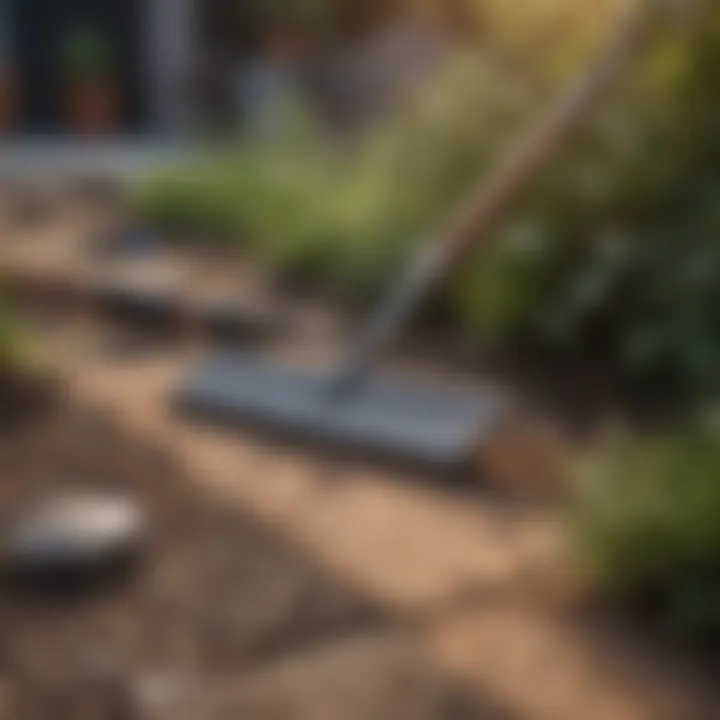
Overall, weeding is a vital aspect of landscape maintenance that requires attention to detail and timely action. Regularly scheduled weeding will not only maintain the beauty of your paved surfaces but will also contribute to their longevity.
Common Types of Weeds Found in Paver Spaces
Understanding the common types of weeds found in paver spaces is crucial for homeowners looking to maintain the visual appeal and structural integrity of their patios, walkways, and driveways. Weeds, by their nature, can rapidly disrupt the cleanliness and organization of these areas. Knowing the specific types can aid in more effective combatting strategies. Here are the three primary categories of weeds that often emerge in these spaces:
Annual Weeds
Annual weeds are plants that complete their life cycle within one growing season. Persicaria, or knotweed, is a common example. It thrives in disturbed soils and often gains traction in the joints of pavers.
Managing annual weeds is not only about removal. It also requires understanding their growth patterns. They typically sprout in the spring and mature by the end of summer. Homeowners must prioritize regular inspections during this period to catch them early. The cycle of annual weeds can become a burden if not addressed promptly. Some characteristics of annual weeds are:
- Quick growth
- Seed production within a short time
- Often shallow root systems
Perennial Weeds
Perennial weeds can be more challenging due to their ability to persist year after year. Dandelions and crabgrass are examples which can root deeply and spread aggressively. Their resilience makes them a prominent nuisance in paver gardens.
For effective management, it’s vital to use various methods. Manual removal can be effective, but one must ensure that the entire root system is extracted to prevent regrowth. This process can often require multiple attempts, particularly with weeds like dandelions. Key points include:
- Can survive winter conditions
- More difficult to remove than annual varieties
- Likely to spread seeds, creating future problems
Invasive Species
Invasive species pose significant threats to local ecosystems and human-managed spaces. These weeds, such as Japanese knotweed and certain types of thistles, take advantage of the gaps in paver areas and often grow in dense clusters. Their aggressive nature can quickly lead to overwhelming situations for homeowners.
Managing invasive species involves a more comprehensive approach, often combining physical removal with chemical treatments. Homeowners should be cautious not to disturb the area excessively, as this can help the invasive species spread further. Notable considerations for invasive weeds:
- Tend to multiply rapidly
- Can outcompete native plants
- Often require long-term eradication strategies
Understanding the specific type of weed can empower homeowners in their maintenance efforts, allowing for targeted solutions tailored to their unique outdoor spaces.
Weeding Techniques for Paver Maintenance
Weeding techniques are vital to the maintenance of pavers, as they directly impact both the appearance and longevity of your outdoor spaces. Without effective weeding, plants can invade the crevices between pavers, disrupt the structural integrity, and create an unkempt look. This section will discuss various methods to keep your pavers weed-free, emphasizing the benefits and considerations of each technique.
Manual Pulling
Manual pulling is one of the simplest yet effective ways to remove weeds. This technique requires no tools beyond your hands and is entirely environmentally friendly. It is also a direct approach that allows the removal of the entire weed, roots and all, reducing the risk of regrowth.
However, this method can be labor-intensive, especially if the area is large or heavily infested with weeds. It is most effective when done after a rain shower or watering because the soil is softer, making it easier to pull out the weeds. While this method has many advantages, it may not be feasible for everyone, depending on physical capability and time constraints.
Using Tools
Weeding Fork
A weeding fork is a specialized tool designed for loosening soil and removing stubborn weeds. Its sharp tines can penetrate into the ground, allowing you to cut the weed roots cleanly. This tool is particularly advantageous for targeting deeper roots which manual pulling might not effectively remove.
The key characteristic of the weeding fork is its ergonomic design, making it comfortable to use for extended periods. This feature helps reduce hand fatigue, especially during lengthy weeding sessions. On the downside, if not handled carefully, a weeding fork can damage adjacent plants if they are not taken into consideration.
Hand Trowel
A hand trowel is versatile and can be used for digging out weeds as well as planting or moving soil. When tackling weeds in tight spaces between pavers, it’s a beneficial choice. Its narrow blade allows for precision, which helps ensure that surrounding plants or pavers are not harmed.
A unique feature of the hand trowel is its compact size, making it ideal for reaching into hard-to-access areas. The disadvantage might be that it requires more effort compared to other tools for larger weeds or extensive weed infestations.
Garden Hoe
The garden hoe is a classic gardening tool with a long handle and a flat blade. This tool is effective for weeding between larger sections of pavers, especially gravel or stone plazas. The key characteristic of the garden hoe is its ability to cover more ground efficiently, making it quicker for larger areas.
While it is fantastic for larger spaces, the unique feature of a garden hoe means precision can suffer. It can inadvertently disturb adjacent plant life or even damage the paver itself. Garden hoes are best suited for open spaces rather than intricate paver designs where careful handling is required.
Chemical Solutions
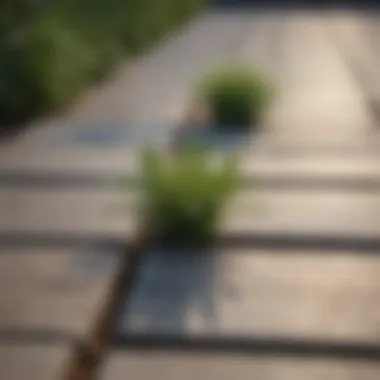
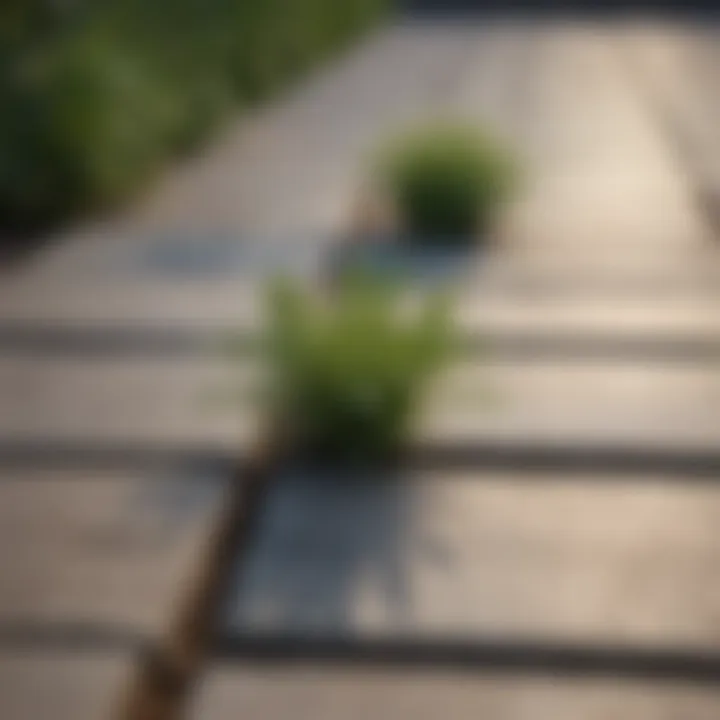
Herbicides
Herbicides are chemical solutions aimed at controlling weed growth. They can be effective in taking care of deeply-rooted or stubborn weeds that manual methods may not eliminate. When used correctly, herbicides can provide a long-term solution for weed problems.
The key characteristic is that many herbicides selectively target specific weed types, which may allow other plants to thrive unharmed. However, there are significant considerations regarding their use, such as the potential impact on nearby plants and wildlife. Improper application can lead to chemical runoff and harm the surrounding environment.
Non-Toxic Options
In light of growing environmental concerns, non-toxic options for weed management are becoming more popular. These solutions often include vinegar or boiling water to kill weeds without harmful chemicals. The benefit is that they generally pose less risk to the ecosystem while being effective against smaller weeds.
The unique feature of non-toxic options is their accessibility; many homeowners may already have these substances at home. However, these solutions may not be as effective against robust weeds and often require repeat applications, which can be labor-sensitive.
"Effective weeding methods can greatly enhance the longevity and aesthetic of your pavers, saving both time and resources in the long run."
Weeding techniques for paver maintenance cover a range of methods, from the manual efforts of pulling weeds to the use of specialized tools and chemical treatments. Selecting the most suitable method depends on several factors, such as the specific type of weed, the extent of infestation, and the homeowner's commitment to either manual or chemical methods. Understanding these techniques not only improves the beauty of your outdoor space but also ensures proper care for the pavers.
Best Practices for Weeding Pavers
Weeding pavers is not merely a seasonal chore; it is a fundamental aspect of landscape maintenance. Best practices in weeding ensure that your outdoor space remains attractive and functional. By following these practices, homeowners can prevent weeds from re-establishing, protect their paver surfaces, and enhance the overall appearance of their environment.
Effective weeding includes understanding the right timing, ensuring proper post-weeding care, and establishing a concise maintenance schedule. Implementing these methods helps maintain the integrity of the pavers and also prevents larger issues related to weed infestations in the future.
Timing Your Weeding
Proper timing is crucial for effective weeding. The best time to weed is generally in the spring and fall. These seasons provide favorable conditions for the removal of weeds, as they are most active during these times. Early morning or late afternoon is also ideal, as the temperature is cooler and the soil is softer, making it easier to pull out weeds by their roots.
Consider the following elements when timing your weeding:
- Seasonal Weeding: Different weeds grow in different seasons. Identify which weeds are prevalent in your area and target them during their growth peak.
- Weather Considerations: Avoid rainy days for manual weeding, as the soil can become muddy and less stable. Aim for dry days when the soil is less compacted.
- Regular Monitoring: Regularly check your paver areas for signs of weed emergence. Early detection can lead to easier removal and a more successful weeding effort.
Post-Weeding Care
After removing weeds, post-weeding care is essential to ensure that the area stays clean and healthy. This step is crucial in preventing regrowth and maintaining the aesthetic value of your landscape.
Key aspects of post-weeding care include:
- Fill in Gaps: After removing weeds, fill any gaps left in the paver joints with fresh jointing material. This reduces the chances of new weeds taking hold.
- Watering Techniques: Watering the area lightly can help settle the ground and keep the soil loose, making it harder for weeds to re-emerge. Be careful not to oversaturate.
- Preventative Treatment: Consider applying a layer of pre-emergent herbicide to deter new weed growth after you weed. Ensure you choose a product that is compatible with the surrounding flora to avoid damage.
Regular Maintenance Schedule
Establishing a regular maintenance schedule is an integral part of paver care. A consistent approach enables homeowners to stay ahead of weed growth and contribute to the pavers' longevity.
A suggested maintenance schedule may include:
- Weekly Checks: Conduct weekly visual inspections of your paved areas to quickly identify new weed growth. Removal of young weeds is much easier than established ones.
- Monthly Weeding: Dedicate time each month for active weeding during peak growth times. This allows for effective removal without overwhelming effort.
- Seasonal Assessments: At the start of each season, assess the condition of the pavers and surrounding areas to formulate a targeted weeding plan for that time of year.
By adhering to these practices, you can significantly enhance the aesthetics of your outdoor space while preserving the integrity and durability of your pavers.
Preventive Measures to Reduce Weeds
Weeds can become a persistent issue in paver areas, but applying preventive measures can significantly reduce their prevalence. Homeowners should understand that taking proactive steps not only preserves the aesthetic value of their outdoor spaces but also enhances the durability of the pavers themselves. Understanding correct preventative methods can benefit homeowners in the long run by minimizing time and effort spent on weeding.
Choosing the Right Jointing Material
The jointing material used between pavers plays a vital role in preventing weed growth. A poor choice may allow weeds to thrive, while the right materials can provide a barrier against their growth. Traditional sand can settle and wash away, leaving space for weeds to take root. On the other hand, polymeric sand offers several advantages. This particular type of sand, when activated with water, forms a durable bond that resists erosion. It also helps to fill gaps more effectively than regular sand, which reduces the likelihood of weeds finding a foothold.
Applying Polymer Sand
After pavers have been installed, applying polymer sand is an essential step. This material not only helps lock the pavers in place but also retards weed growth. When applying polymer sand, it’s crucial to ensure that all joints are filled adequately. In addition, homeowners should allow the sand to cure for the recommended time, generally about 24 hours, before applying water. This process creates a solid connection between the pavers, making it more challenging for weeds to penetrate. Regularly checking the joints over time can help ensure the effectiveness is maintained.
Use of Landscape Fabric
Another effective preventive measure involves the use of landscape fabric. This material creates a physical barrier between the soil and the pavers. By blocking sunlight and restricting access to soil nutrients, landscape fabric can significantly reduce weed germination. Proper installation involves laying the fabric beneath the pavers, covering the soil completely. It is essential to ensure that it overlaps at the seams to prevent weeds from breaking through. For optimal results, homeowners should combine landscape fabric with mulch or gravel on top, which aids in water drainage while further suppressing weed growth.
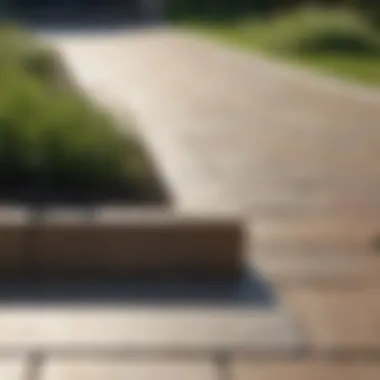

By implementing these preventive measures, homeowners can create a weed-resistant environment in their paver areas, enhancing both aesthetics and longevity.
Environmental Considerations
Weeding pavers involves more than just maintaining appearance; it intersects significantly with environmental factors. Understanding these considerations can help homeowners adopt practices that benefit their outdoor spaces while being mindful of their ecological footprint. This section addresses the impact of chemical interventions and emphasizes sustainable weeding practices that cater to both aesthetics and the well-being of the local ecosystem.
Impact of Chemicals on Surrounding Flora
Using chemicals such as herbicides for paver weed control has drawbacks that may not be immediately apparent. While these products can quickly eliminate unwanted plants, they may adversely affect nearby flora. The chemicals can leach into the soil, potentially harming beneficial insects, earthworms, and nearby plants, which play crucial roles in local biodiversity.
Moreover, many common herbicides are known for their long-lasting presence in the environment. This can lead to the unintended consequence of diminishing plant diversity. Homeowners should reflect on the interconnectedness of their gardens and lawns. When considering a chemical option, it's important to assess the potential risks versus benefits. Some experts advocate the use of targeted application methods, reducing the volume of chemicals used while minimizing the impact on surrounding vegetation.
Sustainable Weeding Practices
In light of the concerns around chemicals, sustainable weeding practices present a viable alternative. These methods focus on preventive measures and the use of natural materials that protect both the pavers and the local ecosystem. Here are key practices worth adopting:
- Regular Monitoring: Developing a routine schedule for inspecting paver spaces helps catch weeds early. Early removal minimizes the chances of weeds going to seed and spreading.
- Mulching: Applying organic mulch around paver areas can suppress weed growth effectively. It creates a protective layer that blocks sunlight and hinders weed germination. Additionally, as it breaks down, organic mulch enriches the soil.
- Natural Herbicides: Options like vinegar or salt can deter weeds without the harsh effects of synthetic chemicals. Though these substances may still have some impact, they are often less severe.
- Plant Selection: Opting for native plants and suitable ground covers can fill empty spaces around pavers, reducing the likelihood that weeds will take root.
Incorporating these sustainable methods can lead to healthier outdoor spaces while aiding in the preservation of the environment. By being more conscientious about weeding practices, homeowners contribute not only to their own landscapes but to a greater ecological balance.
The Role of Weeding in Aesthetic Appeal
Weeding in paver spaces is not only essential for maintenance but also crucial in enhancing the overall aesthetic appeal of your property. When pavers are installed, they typically create a clean outline that should be visually pleasing. However, the presence of weeds disrupts this harmony. An untidy look can detract from the structured design of pathways, patios, or driveways. Homeowners should recognize that weeds can quickly become overwhelming, making even the most sophisticated architecture look neglected.
Weeds can grow through and between pavers, infesting areas that are intended to be free of vegetation. This can lead to unsightly gaps and uneven surfaces. Furthermore, without timely intervention, these weeds can affect the structural integrity of the pavers.
Regular weeding not only keeps your outdoor spaces looking polished but also conveys a message of care and attention to detail. A well-kept exterior reflects positively on the homeowner and can be an expression of personality and pride in one's property.
Enhancing Property Value
Investing in the weeding of paver spaces is directly correlated with enhancing property value. Curb appeal plays a significant role in real estate markets. Properties that are visually appealing tend to attract potential buyers. In fact, experts suggest that homes with well-maintained landscapes can command higher sale prices.
When weeds are controlled, it highlights the quality of the materials used in paver installations. This attention to detail indicates that the homeowner values the property, which can lead buyers to perceive that the home is well-maintained overall. Additionally, a neat and tidy outdoor space encourages outdoor living, which is increasingly desirable among buyers.
- Increased Buyer Interest: Properties that are aesthetically appealing attract more potential buyers.
- Higher Market Value: Well-kept sidewalks and patios can boost the perceived value of your home.
- Appealing First Impressions: A tidy yard creates a lasting first impression that potential buyers will remember.
Creating a Cohesive Landscape
Weeding contributes significantly to creating a cohesive landscape. A landscape is an interconnected system, where each element should complement others. When weeds intrude, they can disrupt this balance, causing disarray that can be visually unpleasing.
By committing to regular weeding, homeowners can promote a more unified appearance. This includes maintaining consistent color schemes, plant choices, and structural alignments. Cohesion in landscapes means that every element works together. Thus, weeding plays a role in ensuring that less desirable plants do not detract from more important features, such as decorative pavers or garden beds.
Keeping your paver areas clear of weeds contributes to a seamless transition between hardscapes and softscapes, enhancing the interplay of textures and colors throughout your garden.
In summary, the role of weeding in aesthetic appeal can not be undervalued. It is essential to both the visual presentation of a home and the integrity of its landscaping. By enhancing property value and creating a cohesive landscape, homeowners can achieve an outdoor space that is not only functional but also inviting.
"A neat outdoor space says a lot about a homeowner's values and much about their investment's quality."
Maintaining clear paver areas through weeding is an investment in both appearance and property value.
The End and Future Considerations
Weeding pavers is more than just an aesthetic pursuit; it is vital for maintaining the structural integrity of outdoor spaces. It's crucial to integrate weeding into a regular home maintenance routine. This practice contributes significantly to the overall appearance and health of your paving.
Summary of Key Points
- Weeding pavers prevents disruptions in your outdoor design.
- It enhances the lifespan of the pavers, saving homeowners money over time.
- Regular maintenance makes future weeding tasks easier and less labor-intensive.
Understanding the weeds that invade paver spaces allows homeowners to select appropriate action steps. Manual pulling, using tools, and applying wise chemical solutions are all effective methods. Also, recognizing the timing and frequency of weeding is essential to keeping your outdoor space beautiful.
Evolving Techniques and Products
The field of landscaping and garden maintenance is continually adapting. New techniques and products are emerging that are more effective and environmentally friendly. These innovations include advanced herbicides that target specific weed types without harming surrounding plants. Moreover, the introduction of polymer sands has revolutionized how we prevent weed growth between pavers.
There are also new weeding tools that enhance efficiency and comfort. For instance, ergonomic hand trowels and weeding forks are becoming widely available. Homeowners should stay informed about these developments, as they can dramatically improve the effectiveness of their weeding efforts.
Embracing both old and new practices can lead to a flourishing outdoor environment. Therefore, regular research into weeding strategies remains essential for homeowners who wish to maintain both the beauty and integrity of their paver installations.
"Regular weeding practices not only enhance appearance but also promote a healthier ecosystem around your home."















